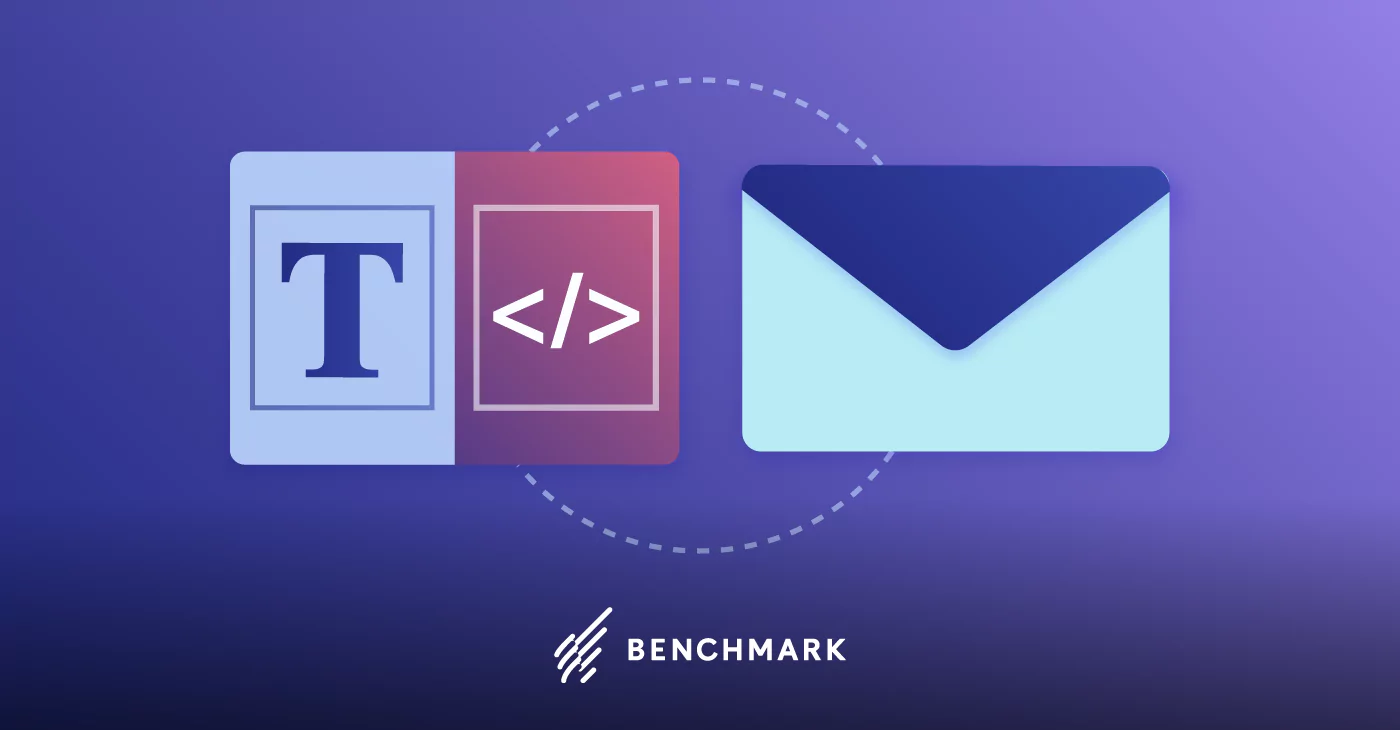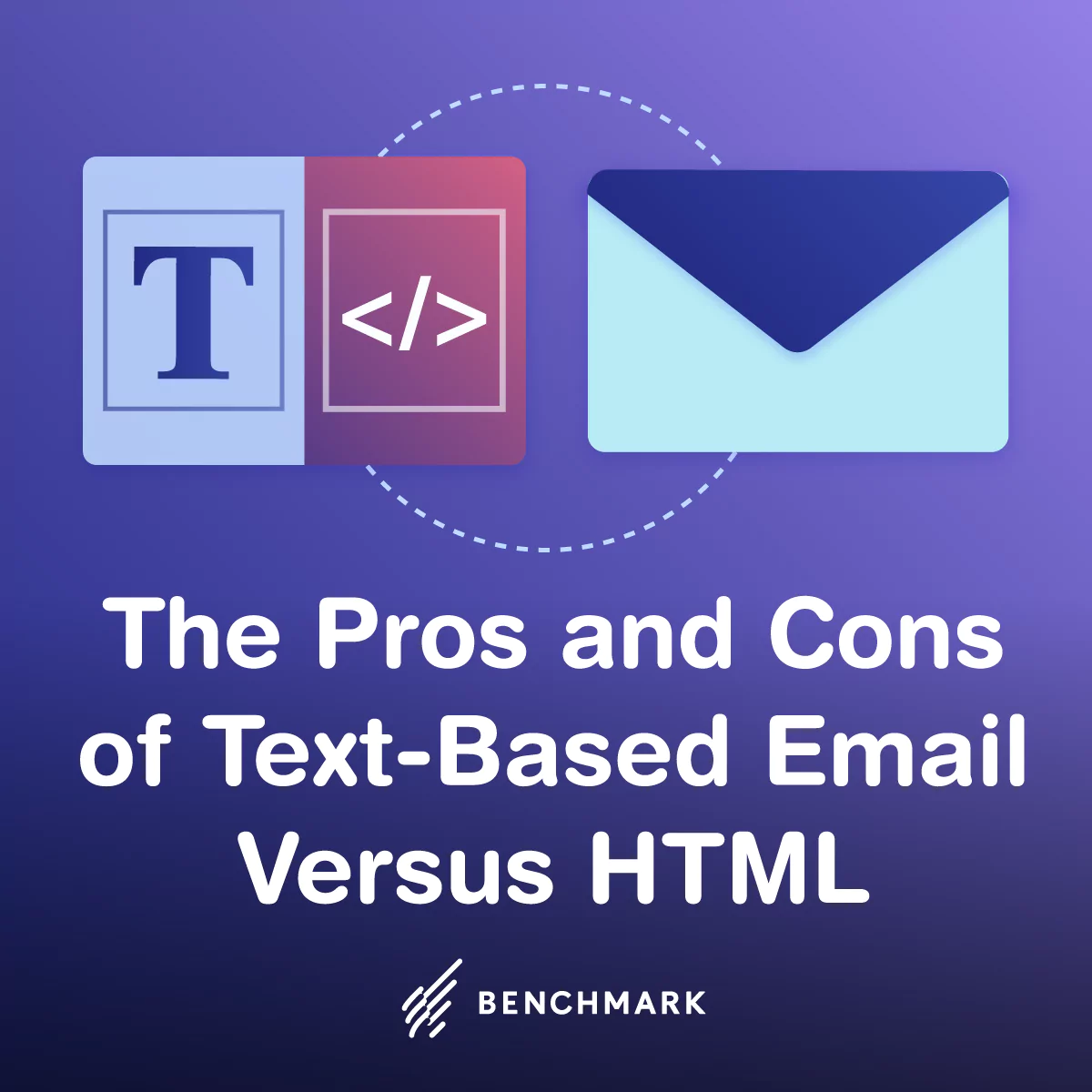
Which is better: text-based emails or HTML? The debate is almost as old as email marketing itself. In 2011 and 2014, HubSpot asked survey takers which they prefer, and both years a majority chose HTML. In practice, though, simple, text-based email designs win out time and time again in A/B testing.
Of course, it would be silly to write off HTML emails — and in fact, images, videos, and creative design elements are some of the most memorable features of successful email marketing. What is there to make of it all then? In this post, we’ll explain the basics of both text-based emails and HTML emails as well as their pros and cons so that you can decide for yourself which is worth your time and effort.

Plain Text Emails
Plain text emails are messages that contain text without any additional flair, such as fonts, colors, or design elements. Nothing is embedded, including images or links. They’re just plain Jane, good ole’ fashion text emails — the same as you might send to your friends or colleagues.
These types of emails were commonplace when emails were first being used in marketing. For obvious reasons, too, considering we hadn’t yet tapped the potential of what emails could be and look like — or built an infrastructure of email tools and platforms to aid in their transformation.
Pros
- They’re better for one-on-one email correspondence. Where plain text emails really excel is with sales letters and updates. They’re inherently personal, and offer quick, clean information without any added fluff.
- They load quickly. No buffering times needed for plain text emails, since there’s not much to load in the first place.
- They work on every device. Mobile, tables, desktops, laptops… you name it, and plain text emails work on it, too. While with HTML, you have to worry about certain features getting warped when going from device to device, plain text appears as-is no matter where you open it.
- They’re more accessible to those with disabilities. Many individuals require the use of read-aloud software for email. The output can be confusing with HTML, however, since there are images and formatting changes breaking up the text. With plain text, the message is straightforward and comes across loud and clear.
Cons
- Their formatting isn’t up to you. When you use plain text in your email marketing, your messages are sent with ASCII text, giving you little to no control over their formatting. Your recipients might see the image broken up in a way you didn’t intend, or with a different font than what you originally used.
- They’re not as engaging. While they do get your point across succinctly, plain text emails lack the fun and engaging touches that you get from including embedded features. With little to draw the eye, the impact of your message is 100% reliant on the copy.
- They’re link-less. Plain text emails don’t make a ton of sense for marketing emails with a landing page CTA since, without links, you can’t directly drive traffic there.
- They’re harder to measure. All those links make the actions recipients take on HTML emails extremely easy to measure. Not so for plain text emails, where your only true measurement is who writes you back.
HTML Emails
HTML (or HyperText Markup Langage) emails are a much more visual approach to email marketing. You can incorporate your own colors, styles, and images, as well as all the links your heart desires. While they originally caused a lot of rendering issues, especially on mobile devices, the rise of responsive design has changed that, making it easier to send HTML emails that look just how you intended them to.
Pros
- They give you more design control. With HTML, you can optimize every design feature to your brand’s image and identity.
- They offer more utility. Images, links, and other media in emails all serve their own unique purposes — and HTML allows you to capitalize (or at least attempt to capitalize) on them.
- They’re engaging. The design elements you include in your HTML emails draw the eye and add variety to the page, all of which is good for performance.
- They’re trackable. With HTML, you can easily track open rates, click-through-rates, and a wide range of other conversion rates.
Cons
- They’re less trustworthy. The average consumer is a lot savvier than they used to be, especially when it comes to email-based malware. As such, they might be wary of links and attachments, since these can spread viruses.
- They’re more likely to go to spam. Email providers use a whole host of different qualifying measures to decide what goes to spam and what goes to the inbox. And because they’re so varied in features, HTML emails tend to send off more red flags than their plain text counterparts.
- They’re less accessible to those with disabilities. HTML emails can be tricky for read-aloud software to adapt for users, which means your message might not come across clearly or concisely.
HTML vs Plain Text Email: Which Performs Better?
Many marketers lean towards HTML emails because they offer better design control than plain text email. However, result-oriented marketers tend to look beyond the design: they examine email performance. We turned to empirical evidence to shed light on how the two types of emails vary performance-wise.
-
Email Deliverability
The first thing you have to consider in the HTML vs plain text email debate is the deliverability score. Email deliverability can dictate the success or failure of your campaigns. The higher the score, the higher the chance of your campaigns getting the desired results. The opposite is also true: sending an email that ends up in the spam folder isn’t a good use of your time.
Plain text emails have a higher deliverability rate than HTML emails. It takes meticulous coding to get HTML emails right, and a simple error such as a broken tag could impact deliverability. So, if you’re crafting an email campaign with HTML, make sure to double and triple check your coding, and use test emails to check how it is likely to appear when it hits the inboxes. If you’re not an expert-coder, a WYSIWYG or drag & drop email builder ensures your email design makes it to the inbox intact.
-
Open Rates
Getting into the subscriber’s inbox is just the first step. For your message to hit home, the subscriber has to open the email. HTML and plain text emails typically post about the same open rate levels, so there’s not necessarily a clear frontrunner here.
However, once opened, there’s another hurdle that HTML emails must clear. Sometimes, anti-virus software can automatically remove the CSS styles of these emails, making it difficult for the reader to decode your message.
-
Click-to-Open and Click-Through Rates
According to statistics, plain text emails garner 21% higher click-to-open rates and 17% higher click-through rates than HTML email. This means that plain text emails are ultimately better at encouraging the subscriber to take the desired action.
Keep in mind, however, the rates will vary across industries, and could differ depending on factors such as subscriber demographics. For this reason, if you’re not sure which type of email to use, do a batch of A/B tests to determine the most effective type of email for your business. Send two versions of the same email to different batches of subscribers for a specified period, and use the rates to help you make an informed decision about the email strategy that works best for you.
When to Use HTML vs Plain Text Emails
The statistics above show that plain text emails deliver better performance than HTML emails. However, this doesn’t mean that you should stop sending HTML emails entirely. If you’re sending emails to a broad customer base with the goal to inform or entertain, then attractive HTML emails could be a great choice. On the other hand, text-based emails are ideal for personal interactions, to relay highly important or timely messages, or simply as an alternative to HTML when there are technical difficulties.
Some marketers are even embracing hybrid emails: an email that is HTML but with less formatting than a traditional HTML email, making it appear more like a plain text email. The type of email that works for your business depends on your industry vertical and the goals you want to achieve with email marketing. Keep a close eye on your metrics to see which email format works best for your brand, and don’t be afraid to try something new if you’re not seeing the results that you want.
Both plain text and HTML emails service a purpose — it just comes down to what you’re trying to achieve. Do what most marketers do and send a hybrid of both to maximize your email marketing potential. Whatever mix of plain text and HTML email you use, Benchmark Email can help you to engage subscribers, nurture leads, and track results. You can sign up for a free account to try it for yourself!



